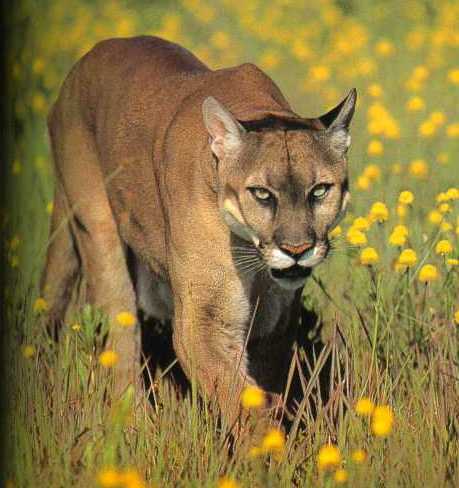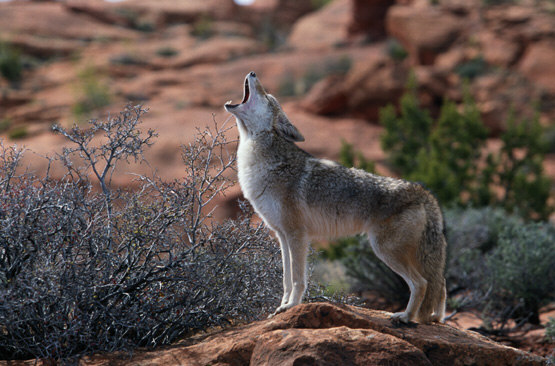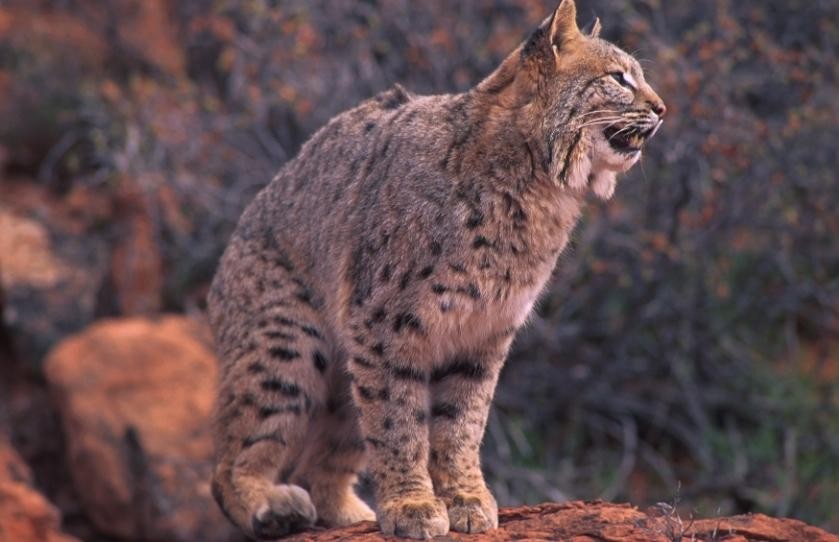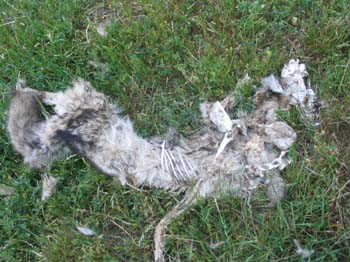|
Predators |
||||
|
Mountain Lions • Coyotes • Bobcats • Other Predators • Poetry/Stories •" Pictures • Audio/Video The predators on Poly Land are extremely important in balancing the populations of animals such as deer and mice. Unfortunately, they are often hunted because of their danger to humans and livestock. As a result, the species that they prey on will often skyrocket in numbers, which has a negative impact on local agriculture and vegetation. |
||||
|
These amazing cats sometimes grow to be 6 feet long and 275 pounds. Their hunting skills have long been both admired and feared by mankind. They are extremely stealthy, hunt at night, and attack from above. These “ghosts of the Rocky's” have been hunted throughout history for their killing of livestock and very rarely, humans. According to Doug Updike, a biologist with the California Department of Fish and Game, “we are not on the menu. If a (mountain) lion had any desire to catch and eat people, we would see literally hundreds of people dying every day.” Mountain lions are an extremely rare site on Poly land, partly because they are most active during the night. “Mountain Loins are predatory carnivores, whose main prey is the white-tailed deer. Other prey species include rabbit, raccoon, wild hog, armadillo, and birds. Research indicates that about 80 to 90% of a lion's diet is deer. An adult lion kills one deer per week. Other prey species include elk and smaller mammals. What the lion does not eat, other predators and scavengers, such as coyotes, foxes, hawks, eagles and crows, use. Prey is dragged to a concealed place before another animal can eat it. The forequarters of the carcass are eaten first, and the rest is buried with grass by the Mountain Lion and fed upon later. Mountain Lions will kill and eat domestic livestock also.”
The coyote has an appearance much like a lean German Shepard. Most coyotes range from gray in color to dark brown and are fairly timid of humans. Coyotes are resourceful creatures, and are known to pick off small dogs or go through human garbage for a snack. It is their resourcefulness that makes them such a remarkably successful species. I have seen them while hiking in desert, coastal, and mountainous regions. It is no surprise that coyotes are omnivorous animals, taking advantage of a wide variety of food resources. “Although the Coyote has been observed killing sheep, poultry and other livestock, it does not subsist on domestic animals. Food habit studies reveal that its principle diet is composed of mice, rabbits, ground squirrels, other small rodents, insects, even reptiles, and fruits and berries of wild plants” Coyotes are known for their bone-chilling howl that seems to make the night less inviting. In fact, these are calls are something we humans should be able to relate to. They simultaneously serve as a territorial warning to other coyotes while attempting to get funky with a female. Click here for one coyote's silky-smooth ballad.
These cute but fierce predators resemble the Canadian Lynx. They are solitary, territorial hunters and may be active during any hour. In general, their activity pattern is based on the activity patterns of prey species. The bobcat is native only to North America and is at home in many habitats from Florida to southern Canada . It has a reputation as being a ferocious, aggressive animal, having evolved among the competition of wolves, coyotes and bears. Experts estimate that between 700,000 and 1.5 million bobcats range through the Untied States alone. It is still legal to hunt the bobcat in most states, and this seems to have little effect on their population due to their adaptability.
"8 to 15 inches, between 1/4 and 1/2 pound, its black nose and eyes are bright against the brown face, reddish brown above and whitish below. Because of their fierce, adroit and voracious behaviors, weasels are effective in controlling the population of mice, rats, gophers, and other rodents." - Cal Poly Land: A Field Guide, ed. Steven Marx, San Luis Obispo 2002, p. 118 Skunks: "13 to 16 inches, between 6 and 14 pounds, it is black with two broad white stripes that run up its back and meet on its head. After warning behavior like foot-stamping, skunks spray a yellow liquid with an offensive odor up to twelve feet. It is produced by glands on either side of the anal opening. The odor arises from the decomposition of certain organic sulfur-containing compounds in the liquid." - Cal Poly: A Field Guide, ed. Steven Marx 2002, p.118
Text References Cal Poly Land: A Field Guide, ed. Steven Marx, San Luis Obispo 2003, p. http://www.desertusa.com:80/june96/du_cycot.html http://www.mountainlion.org/facts_faq.asp http://www.mountain-lions.org/
Saving Tessa Written by Nate Hoverter I remember when I was a kid, I was on a walk with my dad and my dog, Tessa. She was ahead of us, fifty yards or so in a field full of mice and straw colored grass. The coyotes seem to come out of nowhere. One moment Tessa was trotting about the dead grass with a big rock in her mouth and the next, two predators twice her size were twenty yards from her. They were trotting at a healthy pace with their tails slightly higher than horizontal. I knew this was bad news because canines put their tail between their legs when they are feeling afraid and their tail up high when they are feeling aggressive. Tessa was just a six-week-old puppy and I was sure they were going to pick her off. In fact, two days earlier my friend Tim's wiener dog, “Tinkerbell,”, was mauled to death by two coyotes. As they aggressively approached my dog, my dad and I ran toward them to save my dog. My dad yelled, “GO ON, GET!” as I threw a rock at them and they fled instantly. Their tails instantly lowered and they fled at a brisk pace. Tessa was unharmed, although she has reported having nightmares about those ghoulish coyotes ever since.
Night Whispers
Haiku By Kat Lukov Photography By Mollie Small Lurking in Silence.
Picture References
Audio/Visual References
Home • Wildlife • Domesticated Animals • Plants • Poetry and Stories • About Us • Site Map |
||||






![bobcat-tree[1]](../../Web%20Galleries/Predator%20Gallery/thumbnails/bobcat-tree%5B1%5D.jpg)







